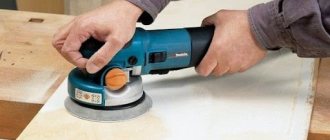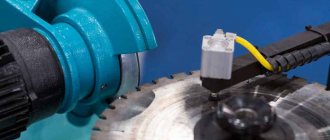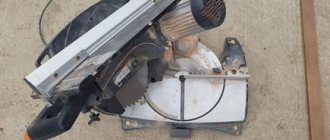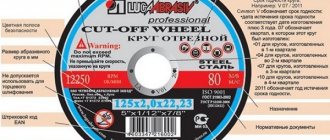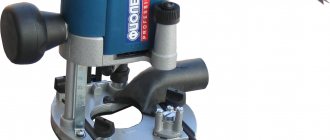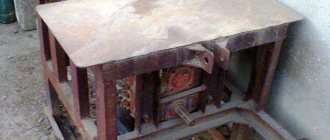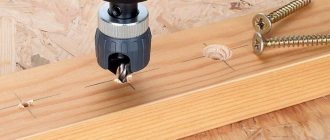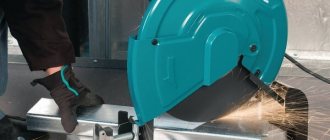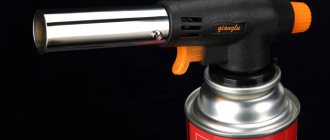One of the ways to influence wood is cutting or sawing. These types of processing are used almost from the very beginning of working with the material.
The standing wood is cut and later sawn into graded lumber. Then, directly at the workplace, the lumber is sawed more than once. For this purpose, circular saws are often used, the main working part of which is the disk.
What to focus on when choosing?
In addition to visually inspecting the disk for irregularities and roughness that increase heating and worsen its balancing, when choosing, you should pay attention to the technical characteristics of the product:
- Equipment type. Monolithic models are inexpensive, but require periodic sharpening and setting of teeth. Carbide blades do not require frequent maintenance, they guarantee decent cutting quality at high speeds and are generally more reliable.
- External diameter. The outer diameter of the equipment is related to the internal dimensions of the casing of the tool used. In addition, the larger the blade, the greater the cutting depth. For hand saws, consumables of 13-25 cm are recommended; discs of larger diameter, as a rule, are intended for stationary units.
- Number of teeth. The number of cutting elements is determined by the specifics of the task. For cross cuts, discs with 80 teeth or more are recommended. Longitudinal sawing is performed using equipment with 60 or less cutting elements.
- Landing diameter. Compatibility of the mounting dimensions of the disk and the tool guarantees tight fixation of the equipment, absence of runout and operator safety. Typical internal diameters for saw wheels are 16, 20, 22, 30 and 32 mm.
- Rotational speed. Depending on the task, saw blades are available in high or low speed. The former are suitable for working with metal, dense and hard wood. The latter cope better with plastic, soft or viscous wood and its derivatives.
Choosing a saw blade: basic rules
But do we all know how to competently choose saw blades for our tools?
But it is precisely the right choice for the tool that will help not only process building materials quickly and efficiently, but also avoid losses due to waste, defects, and injuries.
Often, for various reasons, you have to neglect the purchase of additional consumables. Many people try to make do with one standard blade included with the saw. This is understandable, because a good saw blade costs from 70 to 100 dollars, or even more. But, nevertheless, if sawing work is ahead and it is not at all in your plans to burn out the saw engine, then it is better to approach the issue of choice with all responsibility.
We must also recognize the fact that sellers cannot always give competent advice on choosing circular saws, and documentation for them, as a rule, is missing.
The main dimensions of circular saws are the diameters of the outer circle, the mounting hole and its thickness, which are usually indicated on the saw blade.
By design, they can be divided into saws made of monolithic material and carbide blades, on the tips of the teeth of which there are carbide plates. Typically made from tungsten carbide and cobalt.
Both have their advantages and disadvantages. Monolithic discs become dull quite quickly and require periodic sharpening and setting of teeth. But such a disc can withstand several sharpenings, which are not difficult to do yourself.
More expensive disks with carbide teeth last longer before regrinding, but sharpening them without a special machine is an extremely difficult task. However, carbide-tipped discs have gained the most popularity. First of all, this is due to the economic efficiency and high quality of cutting the material. Therefore, we will consider the latter in more detail.
The tooth shape can have either a negative or positive angle. This angle is formed between the front cutting edge of the tooth and a line drawn from the center of the disk (Fig. 1).
The geometry of sharpening the teeth of the saw blade affects the quality and speed of cutting. Today, the most common forms of tooth sharpening are: flat tooth sharpening, alternating sharpening angle and trapezoid-straight tooth.
Flat (straight) sharpening (Fig. 2) is used for carpentry rough and quick cuts in solid wood, when the quality of the cut does not matter.
Alternating sharpening angles are well suited for clean transverse cuts of hard and soft wood and plywood (Fig. 3).
Trapezoidal sharpening (Fig. 4) is ideal for working on chipboard, plastic, and non-ferrous metals. This sharpening prevents the laminated material from splitting, the trapezoidal tooth performs rough sawing, and the following flat tooth ensures clean cut edges.
If you cut laminated material with saws with an “oblique” sharpening, the main load falls on the top of the triangular angle, which leads to its rather rapid dulling and the appearance of chips. And on cutters with a “trapezoid” there are no sharp corners, so the durability of such saws will be higher than on saws with an “oblique” sharpening.
Of course, you cannot do without chips on a double-sided laminate when sawing with such discs, but the size and number of chips can be significantly reduced. For cutting non-ferrous metals, discs with negative and positive angles are available.
Discs with a negative angle are used when sawing thin-walled profiles, thereby reducing burrs at the exit. Saws with a positive cutting edge angle are used when sawing thick-walled profiles. To increase the resistance of such saws from lateral loads, the bodies are made thicker, unlike saws made on laminated material.
To work with wood, a disk is selected based on the following rules.
It is better to make a longitudinal cut with a disk with fewer teeth, a positive angle of inclination of the teeth and large depressions between the teeth to eject sawdust. For a disc with a diameter of 230-250 mm, the recommended number of teeth should not exceed 18-24 pieces.
For a clean transverse cut, a blade with a large number of teeth is preferable.
There are also saw blades on sale with feed limiters in the form of protrusions behind the carbide brazing of each saw tooth, which limit an excessive increase in the feed speed or its unevenness (Fig. 5). In addition, the stopper prevents damage to the cutting edges by falling knots.
There is quite a lot of information on the disc packaging, which helps you make the right choice. The symbols depict the material for which this disk is intended to work, the cutting direction (transverse or longitudinal), and the permissible maximum speed. You can also “read” the tooth angles - NEG -5*, or POZ 10* (negative and positive, respectively). For clarity, they also display either a miter saw or a hand-held circular saw.
When choosing a blade for a specific job, you need to pay attention to the angle of inclination of the saw teeth, sharpening geometry, expansion slots, protrusions following the tooth to provide support, and recesses between the teeth.
Saw blades according to the type of work can be divided into: saws for cross-cutting wood; saws for longitudinal cutting of wood; saws for laminated materials and saws for cutting non-ferrous metals
Unfortunately, there are no such disks that cope equally well with various materials and tasks, and even with the ability to be installed on any type of tool.
It must be remembered that for better cutting, disks designed for pendulum miter saws are not suitable for hand-held circular saws and circular machines and vice versa.
The reason here is the different trajectory of the disk feeding to the material. Thus, disks for pendulum saws should have a negative angle of inclination, then the cutting part of the teeth is more efficiently used with the least load on the engine. The efficiency is much higher than when using a disk with a positive inclination angle. In the latter case, along the trajectory of the pendulum towards the workpiece, the disk will be partially “buried” by the back side of the tooth, while the load on the engine increases, productivity decreases, and overheating occurs.
At the same time, if you put a disk with a negative angle of inclination on a circular saw or a hand-held circular saw, and even with a large number of teeth, the cut will “repel” the workpiece, sawdust will clog in small recesses, this will cause an overload of the saw motor, longitudinal the cut will be difficult.
To verify this, it is enough to carefully observe the moment at the point of contact of the teeth and the material with the tool turned off. It is most preferable when the saw teeth are directed at an angle to the material, which allows it to be “cut” rather than “cut down”. In the latter case, chips at the exit are guaranteed.
When purchasing a blade, it is very important to consider and foresee not only WHAT is to be cut, but HOW this process will occur and what consequences await us after using an incorrectly selected blade. The wrong choice can ruin the disc and maybe even the tool’s motor.
It is not advisable to install an expensive imported blade on a saw with high axial and radial runouts. There are, for example, discs that have an axial runout tolerance of 0.05%. Some saw bodies undergo additional honing of the mounting holes. It is quite obvious that their use on household-grade machines is not justified.
We have to accept the fact that one disk is not capable of providing both quality and performance at the same time.
To increase the service life and expand the capabilities of the saw, manufacturers use a number of operations. These include: laser cutting of saw bodies, the use of radial grooves, additional processing and coating of the saw body, slots to reduce noise and vibration.
To somehow determine the quality of the saw blade, it is enough to carefully visually examine the body of the saw. Dull teeth can still be sharpened, but a bad disk body cannot be corrected.
When choosing a saw blade, hold it in your hands and look at the direction of grinding of the blade in the light. On a “normal” saw, marks from the grinding tool will radiate in circles from the mounting hole; on a “budget” saw, there will be no such marks. This suggests that in the first case the saw was ground separately, i.e. calibrated after cutting from the sheet. In the second case, they grind and calibrate the entire sheet (if they do it at all). Obviously, the balancing and uniform distribution of internal stresses that arise in work will be more sustainable in the first case.
Also pay attention to how the surface of the disc is polished. If there are roughnesses and rough processing, then it is not difficult to imagine how resin will stick to them. And a dirty tool does not give a good result.
Even on a good saw, the inscriptions will be made with a laser, and not with paint, which will quickly wear off. The inscriptions on the disk will help with its further maintenance. All these and other survey results will tell you how much the manufacturer saved on saws and thought about its consumers.
When cutting material, overheating is extremely undesirable for the discs. The discs “burn” from strong friction against the walls of the cut. The saw is cut, i.e. deviates from a straight cut. Local overheating causes bulges to appear, which due to thermal expansion become larger and rub even harder. Burns appear; due to uneven heating, the saw bends with the propeller. The process develops like an avalanche.
To prevent the disk from “stealing”, there are temperature compensators on its body, which are slots 1-2mm wide and 15-20mm long. These slits are located radially from the interdental cavity and end in round holes. On some blades, these holes are filled with a copper rivet to reduce vibration and improve cooling of the saw.
Also, on the body of the saw blade, to reduce vibration and reduce noise, manufacturers make intricate narrow laser cuts, the configurations of which carry a certain functional load (tension compensators, vibration dampers, temperature compensators, etc.).
The most important parameter of high precision for a circular saw is the absence of deviation from the plane of the saw blade, minimizing its end and radial runout. The cleanliness of processing, productivity, and working life of the tool depend on this.
The disk, no matter how much we want it, is subject to lateral loads, and the task of the disk is to maintain lateral stability, to prevent the disk from “walking.” In addition, it is necessary to sharpen saws in a timely manner, since very dull saws are subject to more intense heating and, as a result, this leads to deformation of the saw blade.
Thinner saws have the advantage: they require less energy, and there is no significant loss of material into sawdust. But, they are less stable in operation and require more “gentle” handling, so for difficult working conditions you should choose thicker saws.
In conclusion, I would like to draw your attention to the fact that when cutting material, it is necessary to reduce the amount of saw teeth extending above the lumber. What beginner tinkerers often don’t do. This increases the quality of the cut, reduces cutting resistance, reduces heat and reduces the load on the engine. The recommended protrusion of the saw teeth above the material being cut should not exceed 10–20 mm. If the machine design has the ability to adjust the height of the disk, follow this rule.
The best disks for circular saws for wood
Equipment of this type can be used when sawing/dissolving logs and boards, cutting blanks from plywood or chipboard.
Rating of the TOP 5 best wood discs in terms of price and quality ratio.
BOSCH Eco Wood 2608644377 190x30
The BOSCH Eco Wood 2608644377 circular saw blade will be useful for various construction works, installation/dismantling of structures, processing of wood blanks and its derivatives.
The equipment provides fast and even cuts and has a long service life under proper operating conditions.
The disc has an outer diameter of 190 mm and an inner diameter of 30 mm.
The model is equipped with cutting teeth with carefully selected geometry and special ultra-precise sharpening.
The presented product is supplied in a convenient blister pack.
Specifications:
- tool diameter - 19.0 cm;
- landing size - 3.0 cm;
- number of cutting elements - 48;
- disc thickness - 1.4 mm;
- cutting width - 2.2 mm;
- maximum speed - 8000 rpm;
- Features: hard alloy, clean cut, for wood.
Advantages
- clean cut;
- no beating;
- workmanship;
- affordable price.
Flaws
- not perfect sharpening;
- noisy model.
Metabo 628060000 216x30
The Metabo 628060000 accessory is designed for clean sawing of soft and hard materials from solid and laminated wood, as well as its derivatives, using a circular saw.
Work with particle boards with hard coating or veneer is allowed.
The blade is compatible with Metabo KS216M Lasercut/KGS216M/KGSV216M/KGSV72 Xact/KGSV72 XactSYM saws.
The consumable is made of ultra-resistant HW/CT alloy, equipped with cutting elements with a WZ shape and a rake angle of 5 degrees.
The model is equipped with 40 teeth and provides precise cutting without chipping or scoring.
Specifications:
- tool diameter - 21.6 cm;
- landing size - 3.0 cm;
- number of cutting elements - 40;
- disc thickness - 1.8 mm;
- cutting width - 2.4 mm;
- maximum speed - 7000 rpm;
- Features: hard alloy, clean cut, for wood.
Advantages
- high quality workmanship;
- good cut cleanliness;
- low cost;
- convenient packaging.
Flaws
- large thickness;
- no tooth tilt;
- high noise level.
Makita M-Force B-31273 190x30
The M-Force Makita B-31273 series saw blade with innovative special M-shaped teeth will provide a perfectly clean cut when working with soft and hard wood.
24 segments with ultra-precise sharpening can significantly increase the speed and quality of work.
The disc itself has a reduced thickness, which, together with the special shape of the edge, reduces friction and reduces the load on the power tool motor.
Beveled cutters form 6 cutting sectors, reducing equipment wear.
The product is supplied in high-quality packaging with dimensions 26×23×1 cm and weighs 320 g.
Specifications:
- tool diameter - 19.0 cm;
- landing size - 3.0 cm;
- number of cutting elements - 24;
- disc thickness - 1.2 mm;
- cutting width - 2 mm;
- maximum speed - 8040 rpm;
- Features: hard alloy, clean cut, for wood.
Advantages
- excellent performance;
- cut with clean and smooth edges;
- light weight;
- high speed.
Flaws
- inflated price tag in comparison with analogues;
- very thin cutting edge.
Makita Standard D-45892 165x20
The Makita D-45892 economy-series Standart saw blade is equipped with cutting elements with the most common ATB shape, providing fast and straight cuts.
All segments are made of high quality carbide steel.
The equipment has a reduced outer diameter of 165 mm and is designed for the use of circular and miter saws with a 20 mm mounting hole.
The consumable provides sawing of wood materials at ultra-high speed.
The maximum value of the latter reaches almost 10 thousand revolutions per minute.
Specifications:
- tool diameter - 16.5 cm;
- landing size - 2.0 cm;
- number of cutting elements - 40;
- disc thickness - 1.4 mm;
- cutting width - 2 mm;
- maximum speed - 9250 rpm;
- Features: hard alloy, for wood.
Advantages
- clean cut;
- hard alloy;
- no heating;
- high speed.
Flaws
- rapid wear of the cutting edge;
- sensitivity to nails and screws;
- high noise level.
BOSCH Construct Wood 2608640633 190x30
BOSCH Construct Wood 2608640633 with specially shaped teeth and a wide base is the ideal solution for processing construction wood, fiber boards and even boards with nails.
The cutting edge in this model provides high resistance and easily copes with hard materials.
The blade with an outer diameter of 19 cm is compatible with miter saws and circular saws with a mounting hole diameter of 3 cm.
A small number of teeth, small diameter, low body thickness and super-sharp sharpening allow you to work with this disc at the highest speed.
Specifications:
- tool diameter - 19.0 cm;
- landing size - 3.0 cm;
- number of cutting elements - 12;
- disc thickness - 1.6 mm;
- cutting width - 2.6 mm;
- maximum speed - 8000 rpm;
- Features: hard alloy, for wood.
Advantages
- high-quality cut;
- copes with nails;
- high speed;
- performance.
Flaws
- requires frequent sharpening;
- large cutting width;
- high price.
Disc parameters for circular saws
Before purchasing, you need to consider several important parameters that characterize the operational features. They include.
Diameter
The outer and outer diameters can be determined by taking into account the size of the protective casing. Large products are not suitable for installation on a circular machine with minimal parameters.
The size of the outer diameter does not in any way affect the speed of work and the depth of cut. Experts say that an incorrectly selected diameter of the cutting base contributes to additional load on the electric motor. As a result, the device overheats;
Bore and inner diameter
This parameter is considered one of the most important. There are several sizes that vary from 16 to 32 cm. There may be additional holes or elements on the surface of the disk for more tight fixation on the surface of the pin;
Number of cutting teeth
These elements have a significant impact on the speed of work and its quality. The minimum number of cutting parts reduces the chip removal rate, which affects the frequency of longitudinal cuts.
Professionals claim that the increased number of teeth ensures uniform division of wood fibers. During operation, the engine heating temperature increases;
Inclination of metal teeth
The position of the cutting part can be determined by measuring the inclination from the radius of the disk relative to the plane of the sharp part. A negative slope represents the deflection of the cutting base towards the back side.
- If it is located in the opposite direction, then it is considered positive.
- For slitting, it is best to choose metal teeth with a positive slope.
- This way, the cutting base will evenly grip the material, which will ensure an even cut.
- In turn, slopes are divided into three categories. They may be standard.
In this case, the angle varies from 5 to 20 degrees. If positive, it will range from 15 to 25 degrees. A negative angle is from 0 to minus 10 degrees;
Teeth arrangement
Each cut variety is designed to handle challenging woodworking tasks. They are divided into several categories.
The flat cutter is used for rip cutting at maximum speed.
- It is recommended to choose it for processing soft wood.
- A replacement cutter combines several alternating cutting parts.
- They can be located in the same or directly proportional plane.
A combined cutter combines several groups made in a certain order. This disc is considered a universal model, which is used for complex work.
The best saw blades for metal
Equipment of this class is intended for cutting relatively hard metals, steels, alloys, and dense composite materials.
The best metal saw blades for a circular saw.
BOSCH Eco Aluminum 2608644391 210x30
The basic model BOSCH Eco Aluminum 2608644391 with fully ground cutting elements is the optimal solution for cutting aluminum using a circular saw.
The disc provides an even cut without the effort of other soft metals and allows you to work with composite materials.
The use of carbide compounds guarantees a long service life of the product.
The presented model is compatible with hand and table saws with a mounting diameter of 30 mm.
The consumable weighs 550 g, has a thickness of 1.8 mm, and provides a cutting width of 2.4 mm.
Specifications:
- tool diameter - 21.0 cm;
- landing size - 3.0 cm;
- number of cutting elements - 64;
- disc thickness - 1.8 mm;
- cutting width - 2.4 mm;
- maximum speed - 7000 rpm;
- Features: hard alloy, for metal/plastic.
Advantages
- high-quality cut;
- excellent balancing;
- high speed;
- affordable price tag.
Flaws
- short service life;
- heating during operation;
- decent noise level.
BOSCH Eco Aluminum 2608644395 254x30
The BOSCH Eco Aluminum 2608644395 circular saw blade with 96 sharp cutting elements will ensure clean and precise cutting of workpieces made of aluminum and other metals.
The equipment is designed for installation on circular saws. The model is made using special carbide materials.
The alternation of ATB and ATB/N type teeth guarantees precise and ultra-clean sawing; special sharpening ensures excellent results.
The product is supplied in ergonomic blister packaging.
The equipment can also be used for processing plastic blanks.
Specifications:
- tool diameter - 25.4 cm;
- landing size - 3.0 cm;
- number of cutting elements - 96;
- disc thickness - 2.2 mm;
- cutting width - 3 mm;
- maximum speed - 6000 rpm;
- Features: hard alloy, for metal/plastic.
Advantages
- versatility;
- good sharpening;
- number of teeth;
- no heating.
Flaws
- not the best quality of materials;
- poor balancing;
- high price.
DeWALT Construction DT1944-QZ 190x30
The professional blade for the DeWALT Construction DT1944-QZ circular saw guarantees a clean and even cut of various metals, as well as plastic, without chips or cracks.
The model has excellent balancing and ensures minimal deviations.
The teeth of the equipment are made in accordance with the ATB format, the elements have a sharpening angle of 16 degrees.
The product is intended for use with miter and circular electric saws.
Supplied in high-quality and convenient packaging with overall dimensions 25×23×1 cm. The weight of the disc with packaging is 320 g.
Specifications:
- tool diameter - 19.0 cm;
- landing size - 3.0 cm;
- number of cutting elements - 24;
- disc thickness - 1.7 mm;
- cutting width - 2.6 mm;
- maximum speed - 7000 rpm;
- Features: hard alloy, for metal/plastic.
Advantages
- clean cut;
- affordable price;
- performance;
- versatility.
Flaws
- short service life;
- noisy model.
BISON Master 36916-190-30-60 190x30
Equipment from the domestic manufacturer BISON Master 36916-190-30-60 will provide high precision cutting of metals and other hard materials on a circular saw.
Increased quality control during the production of this product guarantees a long service life of the saw blade.
The model is made of carbon steel, equipped with carbide cutters VK8.
The teeth are sharpened to TCG specifications and have a cutting angle of 45 degrees.
The manufacturer claims a maximum hardness of the disc body of 42 HRC.
Specifications:
- tool diameter - 19.0 cm;
- landing size - 3.0 cm;
- number of cutting elements - 60;
- disc thickness - 1.4 mm;
- cutting width - 2.2 mm;
- maximum speed - 7000 rpm;
- Features: hard alloy, for metal, universal cut.
Advantages
- affordable price tag;
- thin cut;
- versatility of use;
- quality of execution.
Flaws
- not perfect balancing;
- rapid wear of teeth;
- heating during sawing.
BISON Expert 36907-255-30-80 255x30
Circular saw blade BISON Expert 36907-255-30-80 is a high-quality consumable that allows you to work with a wide range of materials, including metal, wood and plastic.
The model allows for both transverse and longitudinal processing of workpieces.
The cutting elements of the product have high-precision grinding, the edges are supplemented with VK8 carbide plates.
The teeth are sharpened in a special way on three sides.
The presented equipment can be used with saws with a seat with a diameter of 30 mm.
Processing of colored and composite materials, laminate, polymer and epoxy products is allowed.
Specifications:
- tool diameter - 25.5 cm;
- landing size - 3.0 cm;
- number of cutting elements - 80;
- disc thickness - 2 mm;
- cutting width - 2.8 mm;
- maximum speed - 5800 rpm;
- Features: hard alloy, for metal/wood/plastic, longitudinal/transverse cutting.
Advantages
- quality of materials;
- excellent balancing;
- large diameter;
- universal use.
Flaws
- high price;
- large cutting width;
- heavy model.
How to sharpen a disc with your own hands
To sharpen a circular saw, four main angles are taken into account:
- α – clearance angle;
- γ – front angle;
- β – sharpening angle, specified by the rear and front angles (β=90°-γ-α);
- Ɛ1 and Ɛ2 – bevel angles of both front and rear planes.
The sharpening angle of the tool is selected according to the type of material to be processed and the direction of the cut, which is very important when sawing wood. To make cuts along the wood grain, the equipment must have teeth with a sufficiently large rake angle (from 15° to 25°). For cutting across the grain, a rake angle (γ) of 5° to 10° is required. On universal saws that allow you to make cuts both along and across the grain of wood, the rake angle of the cutter has an average value of 15°.
A negative rake angle value is used for tools that will cut plastic, non-ferrous metals and trim wooden workpieces.
In addition, the hardness of the material also affects the sharpening angle. The sharpness of the tooth (β) must be reduced before sawing hard materials.
Sharpening rules
Most often, carbide brazing wears along its top edge. Over time, it grinds down and rounds by approximately 0.1-0.3 mm. The front edge of the cutter also wears out. You should not allow the cutting elements to become too dull, since to straighten the edges you will have to grind off more material from the cutter. The fact that it’s time to sharpen the equipment can be determined by the appearance of the edges of the cutters and the quality of the cut: torn edges with a large number of chips remain.
When sharpening operations are carried out correctly, it becomes possible to sharpen the cutters about 25-30 times. This will ensure the required sharpness of the cutting edge. To achieve such results and significantly extend the service life of the equipment, it is recommended to sharpen the tooth along the back and front planes. Of course, you can grind down one plane of a saw tooth, but the number of attempts will be reduced by 2 times. The figure below shows how grinding a tooth along one and both planes affects the number of sharpenings.
When sharpening the cutters of the equipment, it is recommended to make the last pass with the abrasive along the back plane of the tooth. On average, the amount of grinding of the tooth metal should be in the range of 0.05 – 0.15 mm.
Before starting the sharpening procedure, it is necessary to remove all contaminants from the saw blade and find out the values of the sharpening angles, which are usually indicated on the equipment.
Sharpening a disc at home
Saw blades are usually sharpened on a special machine. It makes no sense to buy a similar machine for your home if you are not going to open a business sharpening accessories for circular saws.
But how to sharpen a circular saw without professional equipment? To sharpen a saw blade with your own hands, you will need:
- tabletop sharpening machine (you can use a grinder for these purposes);
- abrasive wheel (it is better if it is a diamond disc disk for sharpening);
- a simple device that can be made from chipboard scraps.
The last device is a table consisting of a movable upper carriage and a fixed base. The following photo shows the base without the carriage.
In order for the carriage to move correctly, in a horizontal plane, you can attach slats along its edges or install it on furniture telescopic guides. Next, in a certain place on the carriage (found experimentally), a washer with a diameter corresponding to the mounting hole of the equipment is installed.
A saw blade is placed on this washer and, together with the carriage, is moved towards the diamond wheel.
For uniform sharpening, you can screw in a self-tapping screw between two teeth (to the left and to the right of the grinding wheel), which will serve as both a stop and a limiter.
After straightening the first cutter (it is recommended to mark it with a marker), the carriage moves away from the diamond wheel, the disk is moved one tooth along the stops, and sharpening of the circular saw continues.
If you need to grind teeth at an angle, you can place a thin bar of appropriate thickness under the table on one side and sharpen through one tooth. Next, the bar is placed under the other side of the table, and the operation is repeated along the unground incisors.
